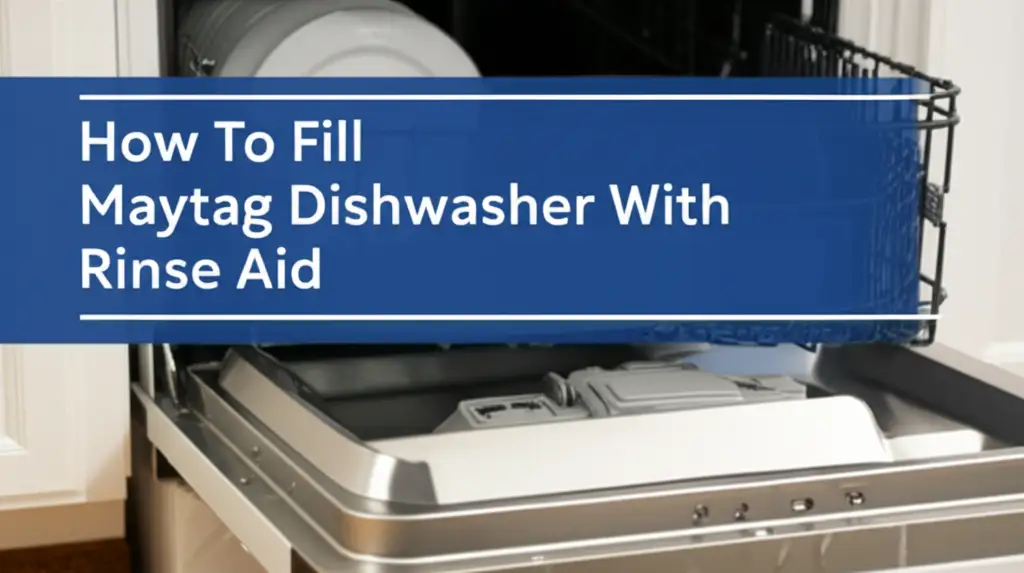· Todd Martin · Appliance Guides · 18 min read
How To Fill Maytag Dishwasher With Rinse Aid

Fill Your Maytag Dishwasher with Rinse Aid: A Simple Guide
Are you tired of pulling out dishes from your Maytag dishwasher only to find them covered in unsightly spots and streaks? Many people face this common problem. The secret to sparkling, spot-free dishes often lies in one simple additive: rinse aid. It is a small step that makes a big difference.
Learning how to fill your Maytag dishwasher with rinse aid ensures your dishes come out clean and dry every time. This guide will walk you through the entire process. We will cover why rinse aid is important, where to find the dispenser, how to fill it correctly, and what to do if you encounter common issues. You will soon enjoy crystal-clear glassware and perfectly dry plates.
Takeaway
- Locate the dispenser: Find the rinse aid dispenser on the inside of your Maytag dishwasher door, near the detergent cup.
- Open and pour: Twist or lift the cap to open the dispenser, then carefully pour liquid rinse aid into the opening.
- Fill to indicator: Stop filling when the indicator shows “full.” Do not overfill.
- Secure the cap: Close the dispenser cap firmly to prevent spills during the wash cycle.
- Wipe spills: Clean any spilled rinse aid to avoid excessive suds.
- Refill when low: Watch for the rinse aid indicator light or check manually to know when to add more.
To fill your Maytag dishwasher with rinse aid, locate the dispenser on the inside door, usually near the detergent cup. Open the cap, pour the liquid rinse aid into the reservoir until the indicator shows it is full, then close the cap firmly. This simple step helps achieve spot-free and dry dishes.
Understanding Rinse Aid: Why Your Maytag Needs It
Rinse aid is a powerful liquid designed to improve your dishwasher’s performance. It works by reducing the surface tension of water. This helps water droplets slide off dishes instead of drying in place and leaving spots. For Maytag owners, using rinse aid means saying goodbye to unsightly water spots and streaks on glassware, cutlery, and plates.
Think of rinse aid as a drying assistant for your Maytag dishwasher. Without it, water often clings to surfaces, leaving mineral deposits as it evaporates. This is especially true if you have hard water in your home. Rinse aid ensures water sheets off quickly, promoting faster drying and preventing those stubborn residues. It makes your dishes look cleaner and can even shorten drying times.
Many wonder, “Why do I need rinse aid if my detergent already cleans?” Detergent cleans, but rinse aid handles the drying process. It helps ensure water drains away completely during the final rinse cycle. This leads to a more efficient drying process. It also helps your Maytag dishwasher perform at its best, giving you consistently sparkling results. Using rinse aid is an important part of proper dishwasher maintenance.
Beyond preventing spots, rinse aid also helps with overall dish hygiene. When water beads up, it can sometimes leave tiny pools that dry slowly, trapping food particles or residue. Rinse aid ensures a cleaner rinse and faster drying, which contributes to a more sanitary outcome. It also protects the interior of your Maytag dishwasher from mineral buildup over time. This can extend the life and efficiency of your appliance.
In summary, rinse aid is not just about aesthetics; it is about function and care. It optimizes the drying cycle of your Maytag, leading to spot-free dishes and a healthier dishwasher environment. Adding it regularly is a small habit that yields significant benefits. You will notice the difference in every load.
Locating the Rinse Aid Dispenser in Your Maytag Dishwasher
Finding the rinse aid dispenser in your Maytag dishwasher is simple. Most Maytag models place this compartment in a very accessible spot. You will usually find it on the inside of the dishwasher door. It sits right next to the detergent dispenser.
Once you open the dishwasher door, look closely at the inner panel. The detergent dispenser is typically a larger compartment for your dish soap. Right beside it, or sometimes integrated into the same unit, you will see a smaller cap or cover. This is the rinse aid dispenser. It often has a symbol of a star or a fan-like icon, indicating its purpose.
The design of the rinse aid dispenser can vary slightly between different Maytag dishwasher models. Some dispensers have a twist-off cap. Others may have a flip-up lid or a pull-out tab. Regardless of the exact design, the function remains the same: to provide an opening for pouring in the liquid rinse aid. If you are unsure, your Maytag owner’s manual will show you the exact location and how to open it for your specific model.
Understanding the layout of your dishwasher’s door is key to proper maintenance. Knowing where the rinse aid compartment is allows for quick and easy refills. It prevents any confusion or accidental pouring into the wrong spot. Always ensure you are targeting the correct small opening designed specifically for liquid rinse aid. This avoids potential issues like excess suds during a wash cycle.
Take a moment to familiarize yourself with your Maytag’s interior. Knowing where each component is located makes regular maintenance a breeze. The rinse aid dispenser is an essential part of achieving sparkling clean dishes. You will find it quickly once you know what to look for.
Step-by-Step Guide: How to Fill Maytag Dishwasher with Rinse Aid
Filling the rinse aid dispenser in your Maytag dishwasher is an easy task. Following these steps ensures proper dispensing and excellent dish cleaning results. I always make sure to have a paper towel ready before I start. This helps clean up any drips.
Here is a simple, step-by-step process:
- Open the dishwasher door: Pull the door down completely so it lies flat. This gives you full access to the dispenser on the inner panel.
- Locate the rinse aid dispenser: As mentioned, this is usually next to the main detergent cup. Look for a smaller circular or rectangular cap. It often has a symbol like a starburst or a fan.
- Open the dispenser cap: How you open it depends on your specific Maytag model. Most commonly, you will either twist the cap counter-clockwise to unlock it, or you will flip a small lid open. Some models may require a gentle pull. The cap will reveal a small opening leading to the rinse aid reservoir.
- Carefully pour the rinse aid: Hold the bottle of liquid rinse aid and slowly pour it into the dispenser opening. Take your time to avoid spills. The dispenser is a small opening. Be gentle to prevent overflowing the reservoir. I always pour slowly.
- Monitor the fill indicator: Most Maytag dishwashers have a small indicator window. This window shows the rinse aid level. It might change color (e.g., from clear to dark) or show “full” or “low” markings. Fill until the indicator shows it is full. Do not fill past the “max” line. Overfilling can cause excessive suds or leaks.
- Close the dispenser cap firmly: Once filled, close the cap securely. If it is a twist-off cap, twist it clockwise until it clicks or feels tight. If it is a flip-up lid, press it down firmly until it latches. A tight seal prevents the rinse aid from leaking out during the wash cycle.
- Wipe away any spills: If any rinse aid spills onto the dishwasher door or interior, wipe it up immediately with a damp cloth. Spilled rinse aid can cause too many suds during the wash cycle, which can lead to poor cleaning results or even leaks.
This process is generally the same for many Maytag models. By following these steps, you are well on your way to enjoying beautifully clean and dry dishes. For a quick reference on this common task, you can also see how to put rinse aid in a Maytag dishwasher via official guidelines. Regularly checking and refilling your rinse aid ensures consistent performance from your Maytag appliance.
Knowing When to Refill Your Maytag Dishwasher’s Rinse Aid
Knowing when to add more rinse aid to your Maytag dishwasher is key for continuous sparkling dishes. Fortunately, Maytag makes it easy with a clear indicator system. Most modern Maytag dishwashers have a dedicated rinse aid indicator light. This light typically illuminates on the control panel when the rinse aid level is low.
When you see the rinse aid light turn on, it is your signal to refill the dispenser. The light usually goes off once you have replenished the supply. This feature takes the guesswork out of maintenance. It ensures you never run out of rinse aid unexpectedly. Pay attention to your dishwasher’s display after each cycle.
Even without a light, you can visually check the dispenser. Open the rinse aid compartment and look at the small indicator window. This window might change color or show a “fill” line. If the color is faded or the level is below the “fill” mark, it is time for a refill. I like to glance at this window every few weeks, just to be sure. This manual check is a good habit to develop.
Beyond indicators, your dishes themselves will tell you when rinse aid is low. If you start noticing water spots, streaks, or wet dishes after a cycle, it is a strong sign. These issues indicate that the water is not shedding off properly. This means your rinse aid supply is likely depleted. It is important to address this promptly to maintain dish quality.
The frequency of refilling depends on how often you use your dishwasher and the hardness of your water. If you run cycles daily, you might need to refill every few weeks. If you only use it a few times a week, it might last a month or more. Harder water often consumes rinse aid faster because it requires more to counteract mineral deposits. When the rinse aid light is on the dishwasher, it directly tells you to replenish the supply. Understanding how to know when rinse aid is empty empowers you to keep your Maytag performing at its best.
Common Rinse Aid Issues and Troubleshooting for Maytag Dishwashers
While using rinse aid in your Maytag dishwasher is straightforward, sometimes issues can arise. Understanding these common problems and how to fix them helps maintain excellent dish cleaning. I have encountered a few of these myself, and they are usually easy to resolve.
1. Overfilling the Rinse Aid Dispenser: This is a frequent mistake. If you pour too much rinse aid, it can lead to excessive suds in the dishwasher. You might notice suds overflowing from the dishwasher door or dishes feeling slimy.
- Solution: If you overfilled, gently use a syringe or a paper towel to soak up the excess liquid. Run a short rinse cycle with no dishes to clear out any remaining foam. For detailed instructions on removing excess, you can look into how to get rinse aid out of a dishwasher. Always fill to the “max” line, not above it.
2. Rinse Aid Not Dispensing: Sometimes, rinse aid stays in the dispenser even after a cycle. This could be due to a clogged dispenser cap or internal mechanism. Food particles or dried rinse aid can block the opening.
- Solution: Check the dispenser cap for any blockages. Clean it with a small brush or toothpick. If the problem persists, the dispenser might be faulty. In this case, you may need a service technician to inspect or replace it.
3. Dishes Still Spotty After Adding Rinse Aid: You filled the dispenser, but spots persist. This can be frustrating. Several factors could cause this.
- Solution:
- Check Rinse Aid Setting: Your Maytag dishwasher might have an adjustable rinse aid dispenser setting. Increase the dispense amount if your water is very hard. Consult your manual for how to adjust this.
- Water Hardness: Very hard water might require more rinse aid or a specialized product for hard water.
- Detergent Quality: Ensure you are using a high-quality dishwasher detergent. Sometimes, the issue is not the rinse aid but the cleaning power of the detergent.
- Overloading: Too many dishes can block water spray, preventing rinse aid from reaching all surfaces. Avoid overcrowding your dishwasher.
4. Rinse Aid Light Stays On (or Off): If the rinse aid light on your Maytag’s control panel is always on, even after filling, or never turns on when low, there might be a sensor issue.
- Solution:
- Light On: Ensure the cap is fully closed. Sometimes a loose cap keeps the sensor triggered. If it persists, the sensor might be defective.
- Light Off: If the light never comes on, the sensor might be faulty, or there’s an electrical issue. Check your Maytag’s circuit breaker first. If it is still off, professional help might be needed.
Troubleshooting these issues often involves simple checks. Addressing them quickly ensures your Maytag dishwasher continues to deliver optimal cleaning and drying results. Always refer to your Maytag owner’s manual for model-specific troubleshooting tips.
Choosing the Right Rinse Aid and Alternatives for Your Maytag
Selecting the right rinse aid for your Maytag dishwasher can enhance its performance. While many brands offer rinse aid, understanding the differences helps you make an informed choice. I always consider my water type when picking a product.
Types of Rinse Aid:
- Liquid Rinse Aid: This is the most common form. You pour it directly into the dishwasher’s dispenser. It works by releasing a small amount during the final rinse cycle. Liquid rinse aids are effective for reducing spots and improving drying. Most Maytag dishwashers are designed for liquid rinse aid.
- Dishwasher Pods/Tablets with Built-in Rinse Aid: Many all-in-one detergent pods now include rinse aid. These are convenient because you do not need to fill a separate dispenser. However, the amount of rinse aid in these pods is fixed. It may not be enough for very hard water conditions. If your Maytag has a dedicated rinse aid dispenser, using liquid rinse aid usually provides better control and results.
Maytag Recommended Brands vs. Generics:
Maytag does not typically endorse one specific brand of rinse aid. Most major brands like Finish, Cascade, or Quantum will work well. The key is to choose a high-quality product. Cheaper or generic brands might not provide the same spot-prevention power. Look for rinse aids designed to reduce surface tension and promote sheeting action. Your water hardness should also influence your choice. Some rinse aids are specially formulated for hard water. These can offer extra protection against mineral deposits.
Considering Water Hardness:
Water hardness significantly affects rinse aid performance. Hard water contains high levels of minerals like calcium and magnesium. These minerals are the primary cause of water spots. If you have hard water, you might need to adjust your dishwasher’s rinse aid setting to dispense more. Some Maytag models allow you to do this. You might also benefit from rinse aid products marketed specifically for hard water. These products contain stronger formulas to combat mineral buildup.
Vinegar as an Alternative:
Some people use white vinegar as a natural alternative to commercial rinse aid. Vinegar is acidic and can help reduce water spots. It can also act as a natural disinfectant.
- How to Use: You can pour white vinegar into the rinse aid dispenser. However, use it with caution.
- Caveats:
- Rubber Seals: Over time, vinegar’s acidity might potentially degrade rubber seals and hoses in some dishwashers. This is a rare risk, but it is worth noting.
- Effectiveness: Vinegar may not be as effective as commercial rinse aids, especially in very hard water. It also lacks the specific surfactants found in commercial products that are designed for optimal sheeting and drying.
- Smell: While the smell usually dissipates, some people might notice a slight vinegar odor in their dishwasher. If you are interested in trying this, learn how to use vinegar as rinse aid in a dishwasher safely.
Ultimately, the best rinse aid for your Maytag will depend on your personal preference and water conditions. Experiment with a few quality liquid rinse aids to see which one gives you the best results.
Maintaining Optimal Maytag Dishwasher Performance with Rinse Aid
Using rinse aid correctly is a cornerstone of effective dishwasher maintenance for your Maytag. It goes beyond just filling the dispenser. Consistent care ensures your Maytag dishwasher delivers spotless dishes for years. I find that a little extra attention goes a long way.
Regular Checks of Rinse Aid Levels:
Make it a habit to check your rinse aid level regularly. Do not wait for the indicator light to come on every time. A quick visual check of the dispenser window every week or two can prevent running out. This proactive approach ensures consistent performance. It also saves you from those frustrating moments of finding spotty dishes.
Cleaning the Dispenser Area:
Sometimes, rinse aid can drip or accumulate around the dispenser opening. This residue can become sticky or attract dirt. Over time, it might even clog the dispenser mechanism.
- Solution: Periodically wipe down the entire dispenser area with a damp cloth. This keeps the dispenser clean and functioning smoothly. Ensure the cap or lid is also clean and seals properly. A clean dispenser ensures optimal flow of the rinse aid during cycles.
Ensuring Correct Dispense Setting:
Many Maytag dishwashers allow you to adjust how much rinse aid is dispensed per cycle. This setting is crucial for optimal results, especially with varying water hardness.
- Adjustment: If you have soft water, you might need a lower setting to avoid excessive suds or a rainbow sheen on dishes. If you have hard water, a higher setting will provide better spot prevention. Refer to your Maytag manual to learn how to access and change this setting. Getting the setting right prevents issues and maximizes efficiency.
Using Quality Rinse Aid Consistently:
Do not compromise on the quality of your rinse aid. While it might seem like a minor expense, a good quality rinse aid is essential. It provides the necessary agents for proper sheeting and drying. Using it consistently with every wash cycle helps prevent mineral buildup inside your dishwasher. It also ensures your dishes always come out pristine. Inconsistent use can lead to fluctuating performance and eventual spotting.
Overall Dishwasher Care:
Rinse aid works best as part of a comprehensive maintenance routine.
- Load Properly: Do not overload your Maytag dishwasher. Proper loading allows water and rinse aid to reach all surfaces.
- Clean Filters: Regularly clean your dishwasher’s filter. A clogged filter affects cleaning and rinsing efficiency.
- Run Hot Water: Ensure hot water is supplied to the dishwasher. Hot water activates detergents and rinse aids more effectively.
By paying attention to these details, you ensure that your Maytag dishwasher continues to operate at its peak. This delivers the spotless, dry dishes you expect every single time. Rinse aid is a powerful tool when used correctly.
FAQ Section
Can I run my Maytag without rinse aid? Yes, you can run your Maytag dishwasher without rinse aid. The dishwasher will still clean your dishes. However, you might notice water spots, streaks, or wet dishes, especially if you have hard water. Rinse aid greatly improves drying and prevents these unsightly marks.
How often should I add rinse aid to my Maytag? The frequency depends on how often you use your dishwasher and your water hardness. Most Maytag dishwashers need a refill every few weeks to a month with regular use. The rinse aid indicator light on your control panel will signal when it is low.
What happens if I overfill the rinse aid dispenser? Overfilling the rinse aid dispenser can cause excessive suds during the wash cycle. This might lead to suds overflowing from the dishwasher door. Your dishes might also come out with a slimy or streaky residue. Wipe up any spills immediately and consider running a short cycle without dishes.
Why are my dishes still spotty after adding rinse aid? Several factors can cause this. Check if the rinse aid dispenser is working correctly. Ensure you filled it to the proper level. Your rinse aid dispense setting might be too low, especially with hard water. Also, consider the quality of your detergent or if your dishwasher is overloaded.
Is all rinse aid the same for Maytag dishwashers? Most liquid rinse aids are compatible with Maytag dishwashers. While they all aim to reduce water spots, their effectiveness can vary by brand and formulation. Some rinse aids are designed specifically for hard water. High-quality brands often provide better results than cheaper or generic options.
Conclusion
Achieving sparkling, spot-free dishes from your Maytag dishwasher is simpler than you might think. The key is understanding and consistently utilizing rinse aid. We have walked through the process of how to fill Maytag dishwasher with rinse aid, from locating the dispenser to troubleshooting common issues. It is a straightforward task that significantly impacts your dish cleaning results.
Remember, rinse aid reduces water surface tension. This allows water to sheet off dishes easily, preventing spots and promoting efficient drying. By regularly checking the rinse aid indicator and refilling your dispenser, you ensure your Maytag operates at its best. This simple habit keeps your glassware crystal clear and your plates perfectly dry.
Take control of your dishwashing experience. Embrace the power of rinse aid for a visibly cleaner outcome. Your Maytag dishwasher is designed to deliver exceptional results, and rinse aid helps it achieve just that. Enjoy the satisfaction of pulling out brilliantly clean dishes every single time. Make filling your rinse aid dispenser a regular part of your home maintenance routine.





